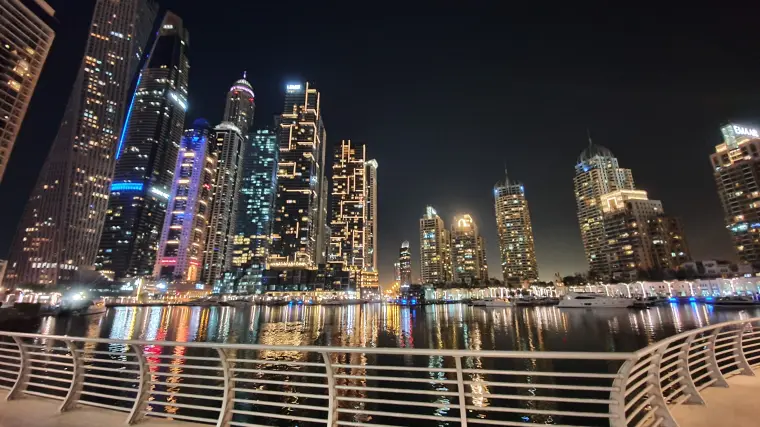Passive Fire Protection in High-Rise Buildings
Imagine a metropolis without a skyline! Its hardly possible. If you think of any big city you will imagine its buildings, monuments, the people, your favorite places and eventually, its skyscrapers.

The skyline is the integral image of a city. Giants that seem indestructible. But what about the risk of fires? What do we do to protect them right from the start of construction?
Fires in high-rise buildings are not a phenomenon of the present. Conflagrative damage and fast-spreading fires have caused many deaths ever since high-rise buildings were first built. However, the terrible images of Dubai, London and others still remain in front of our mind’s eye. But let’s step back a little. Firstly, we need to discuss the role of passive fire protection and what it contains. After that we can take a look at present trends, developments and what we can learn from past fires in high-rise buildings.
What is Passive Fire Protection?
Passive fire protection (PFP) is as its name suggests an idle form of safety. It is embedded in the structure of the building and therefore designed to prevent the fast spread of flames, smoke and hot gases. Its main purpose is to slow down fire in order to evacuate safely and give more time for the emergency services. So, if you are a Safety Manager of a building, it is your responsibility to keep safe the people that are normally in the building, but moreover as many do forget, members of the emergency services. Keeping the building as safe as possible when a fire occurs is the main function of passive fire protection.
What are the elements of passive fire protection?
According to Chris Jelenewicz, Technical Director at the Society of Fire Protection Engineers (SFPE), there are four elements of passive fire protection: 1. Structural fire protection, 2. Compartmentation, 3. Opening protection, and 4. Firestopping materials.
- As the name suggests, Structural Fire Protection guards the building’s structure when fires occur. The use of fireproof materials such as fireproofing spray, intumescent coatings, rigid board fireproofing, flexible blanket systems or autoclaved aerated concrete are therefore required.
- Compartmentation means that the building has internal barriers to prevent fire spreading, and provides refuge and safe evacuation paths. Fire barriers, firewalls, fire partitions, and smoke barriers can all be used for compartmentation. These compartments are structurally thick and stable enough to provide standing walls even if parts of the building collapse.
- Other fire hazards in the building are openings in fire barriers. So, in order to ensure an effective barrier function, openings should be closed by doors, frames, fire-rated glass and even fire and smoke dampers for ducts. These Opening Protections work together to maintain the fire resistance of fire barriers.
- “It’s not uncommon to see a fire barrier penetrated during a minor building alteration, and then the penetrating item isn’t protected by firestopping,” so Jelenewicz. As you can tell, the fire barriers need to remain, even if fire penetrates into them. The use of Firestopping Materials is crucial to keep those compartments as safe as possible.
We can conclude that the most common and little things like water pipes, electrical sockets, cable trunking, and lighting units can add up to fire spread. Therefore, another task of PFP is to seal gaps and air ways that help fire to grow fast.
What Role Does the Façade Play in a Fire?
As we learned from the above, even a little oxygen can fuel devastating fires. So, protecting the outside walls is crucially necessary. Unfortunately, flammable cladding has still been the cause of many recent fires. But what exactly happened in London, Grenfell?
As Prof. Reinhard Ries, the Director of the Fire and Disaster Control in Frankfurt a. M. says in his interview with Süddeutsche Zeitung: “[W]e have seen the floor plan of the building and we analyzed the images. This makes it quite clear that the fire has spread over the façade. According to previous information, the fire broke out in one of the lower floors in the commercial premises, where there are no people at night, so it didn’t attract attention. As soon as the fire reached the façade, it spread as quick as lightning.”
But not only the materials of the façade and insulation are a hazard, it is a combination of both - oxygen and highly flammable materials - that work together as a ferocious duo. “We know now that on the outer wall of the London high-rise building a combustible thermal insulation was attached. Metal panels were attached to them, probably with dowels and screws, so that there was a distance between them in which air could circulate. Thus, as soon as it ignites, it acts as a stove”, Ries concludes.
One might argue why it is permitted to build high-rise buildings with such materials. However, it is not yet mandatory to build skyscrapers with non-flammable insulation or exterior wall assemblies. At least not in many parts of the world. Ries advocated for such mandatory regulations in his country: “In Germany, special rules apply to high-rise buildings whose top floor is higher than 22 meters. The façades must not be made of combustible material. This is expensive, but it has been applied here since the 1980s, and we firefighters are fighting hard for it to continue”. This is not the case for many other countries.
New Regulation in the UK since January 2023
According to Quadrant there are new Fire Safety Regulations that came into force on 23 January 2023 and apply in England. "These regulations will make it a requirement in law for responsible persons* of high-rise blocks of flats to provide information to Fire and Rescue Services to assist them to plan and, if needed, provide an effective operational response.
The regulations will also require responsible persons in multi-occupied residential buildings which are high-rise buildings, (defined in The Fire Safety (England) Regulations as a building at least 18 metres in height or at least seven storeys,) as well as those above 11 metres in height, to provide additional safety measures." (Quadrant)
What Can We Learn From the Dubai Fires?
According to the New York Times, the United Arab Emirates re-evaluated its regulations after the fire in 2015. They added restrictions to exterior paneling for new constructions and even banned it for towers that are higher than nine stories. Nonetheless, this is only a first step. Many thousand buildings are still built according to previous regulations.
Second Fire in 'The Torch' in Dubai
What can we learn from the second fire of ‘The Torch’ in Dubai? Applying regulations is not as easy as setting them up. As the Gulf News published in April 2017, the second upgrade of the new fire code was enhanced up to 1,562 pages (previously 707 pages) including 20 chapters and many illustrations to make building planning easier and safer. This new code is an important step to raise awareness of fire risks such as flammable claddings. Building owners and maintenance providers are called to pay more attention to maintain the building and to exchange cladding systems over time. A detailed maintenance manual with specifications of built-in materials should be provided by the developer for the property manager.
If the building was built before 2012, property managers can only speculate about the materials – especially with regard to the cladding. Although flammable cladding enhances fires tremendously, it does not cause fires in the first place. Faulty electrical circuits and generators are the most common reasons of fire incidents in buildings in the UAE that caused at least 70 percent of the fires there.
How about Standard Tests?
Chris Jelenewicz (cited above) mentioned several test standards that evaluate exterior, non-load-bearing wall assemblies including combustible components. In the USA the most common method is presented in the NFPA 285 standard. Canada has its own standard (CAN/ULC S-134), as well as the United Kingdom (BS 8414) and Germany (e.g. DIN 4102-3). The world-wide standard regulation is outlined in the ISO 13785 ‘Reaction-to-fire tests for façades’.
Wood for High-Rise Buildings?
Let’s stay mentally in the Middle East for a little while. Especially in Dubai, high-rise buildings have popped up in great numbers. So, the idea rose to build environmentally more responsible buildings – not only in the Middle East that is. Alternate materials are on the rise. Tall buildings with structual componants comprised of engineered wood are on high demand. According to Chris Jelenewicz that is, because engineered timber products are a renewable resource compared to other types of structural systems. After demolition, wood can be re-used and much less energy is needed during manufacturing processes.
Wood and Fire Safety?
Combustibility and stability are the main concerns that come up when mentioning wood as a construction material. Jelenewicz negates these concerns: “[W]ood is often perceived to be unsafe when exposed to fire. […] The reality, however, is that timber systems perform well when exposed to fire. The fire protection engineering community has completed a substantial amount of research on the performance of timber structures when exposed to fire conditions. When timber is exposed to fire, the outer layer burns and is charred. This creates a protective layer that acts as insulation that delays the onset of heating to the unheated side. This allows the timber assembly to maintain its structural capacity for extended durations.”












